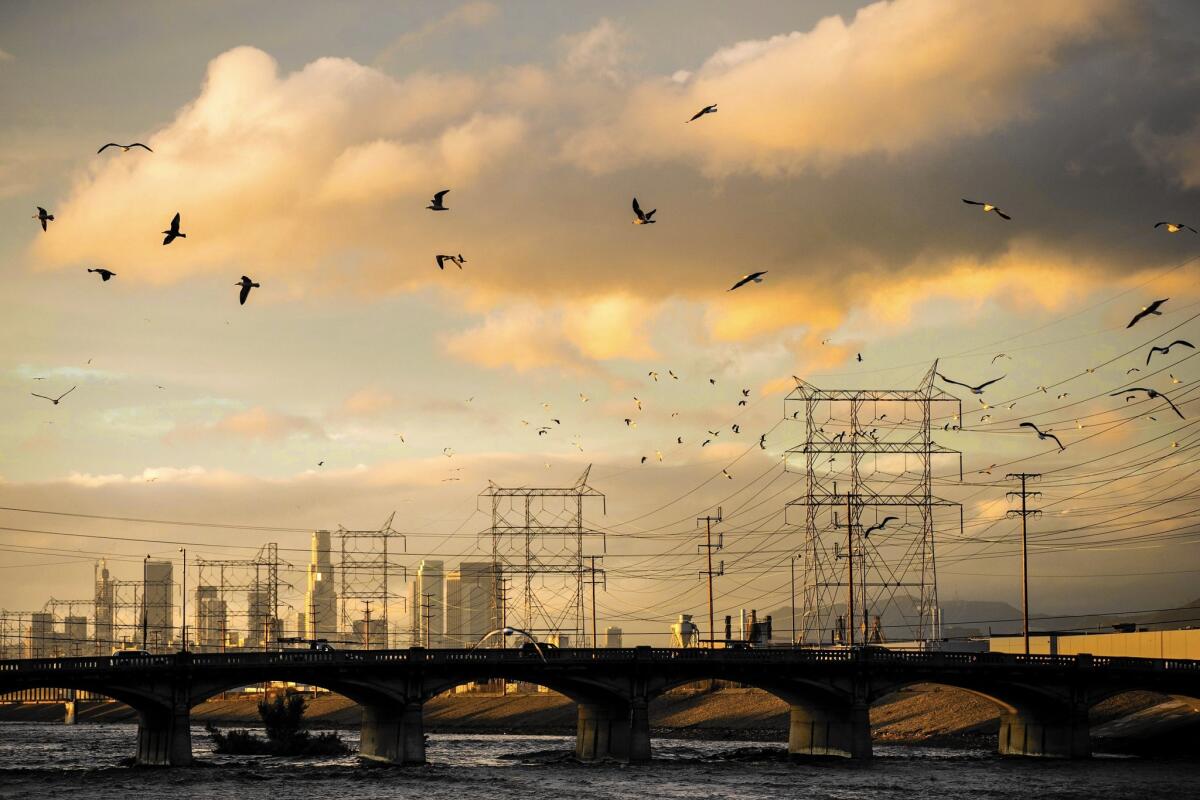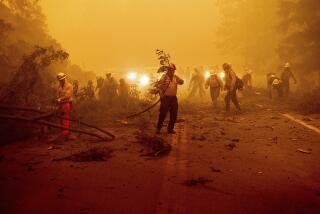Capitol Journal: Parks are pork, but flood control saves lives. That’s the tension just under the surface of the L.A. River

- Share via
Reporting from Sacramento — All politics are local. That’s long-proven dogma. One gleaming example involves the Los Angeles River.
The L.A. River is a key negotiation point in legislative talks to create a state water and parks bond proposal. Not just the 48-mile river itself, but separate sections of it. That’s how local this issue is.
Should most of the river money go to Senate leader Kevin de León’s district upstream from downtown L.A.? Or should it wind up in Assembly Speaker Anthony Rendon’s district along the lower river?
There’s “tension” between the Legislature’s two Democratic leaders over that, I’m told. It’ll no doubt be worked out. A 50-50 split is the best bet.
But currently, De León’s $3.5-billion water and parks bond bill heavily favors his district. A rival $3.1-billion parks bill by Assemblyman Eduardo Garcia (D-Coachella) has a more equal divide. Rendon, however, will be the Assembly negotiator for his end of the river.
About $100 million is involved. The goal in recent years has been to restore the waterway to look more like a real river, not just a concrete storm canal. Some vegetation and wildlife, even parks, are showing up and removing eyesores.
But which parts of the river should be restored? California voters in 2014 passed a $7.5-billion water bond that included $100 million for the L.A. River. The Legislature then took almost three years to agree how to spend it. Finally, as part of the recently passed state budget, De León and Rendon settled on a roughly 50-50 split between the upper and lower rivers.
De León’s bond bill recently passed the Senate on a bipartisan 31-9 vote. It includes $2.25 billion for parks, $500 million for water facilities and $750 million for flood protection.
Garcia’s bond proposal passed the Assembly on a more party-line vote, 54 to 19. All of its money is targeted for parks.
The two measures ultimately are expected to be merged and the money divvied among parks, water and flood projects.
But given climate change, the life-or-death consequences of anticipated increased flooding and the fact that California just emerged from a severe five-year drought, why does the Legislature want to spend any new money at all on parks? Why not just pour it all into flood control and water development?
Yes, there’s a $1-billion backlog in deferred parks maintenance. And parks enhance people’s lives. But floods take lives. And with more thirsty nut trees taking root in the arid San Joaquin Valley and California’s population still growing, we should be spending a lot more on our plumbing.
Here’s the honest truth about parks, especially urban parks: They’re great pork for politicians. They make their voters happy and provide convenient ribbon-cutting photo ops.
Legislative leaders are hoping to pass a parks-water-flood control bill before this year’s session ends in mid-September. But the mystery man is Gov. Jerry Brown. He’ll need to sign the bill.
Brown is a proud tightwad who abhors debt, a trait appealing to voters that accounts for his high popularity. Bonds double a project’s sticker price because of interest. So Brown resists bonds.
The governor hasn’t said squat about this proposed bond, or even shown any interest. But because water’s a popular need, he’s expected to weigh in at the last minute and dictate the compromise.
Legislators are aiming for the June 2018 primary election. That’s so the bond proposal won’t have to compete with all the privately sponsored initiatives in November. Two of them are expected to be rival water and parks bond measures.
Democrats decreed a few years back that only measures from the Legislature could be placed on a primary ballot. At the time, the idea was to force all right-leaning initiatives onto the November ballot where larger voter turnouts would help Democratic causes.
While legislators are tussling over park pork and river sections, there are outside efforts to add extra money for flood control. California faces a future of more volatile winters with warmer storms that threaten farms and cities. This past winter provided a preview.
“We’ve got a narrow window to make progress on water and flood control,” says Barry Nelson, a longtime environmental advocate who now works for the salmon fishing industry. “Once a drought and flooding are over, people move on.
“But if you look at what climate change means, it’s sobering. They’re predicting a 69% increase in peak flood flows.”
Nelson adds that during the past winter “we got lucky. But the luck of the draw is not a flood plan.”
Even with a good plan, he continues, “the difference between a plan that sits on the shelf and one that gets implemented is funding. So the Legislature has a big decision coming up on flood bonds.”
Nelson and many modern water experts are huge advocates of creating more flood bypasses around cities — the Yolo Bypass on Sacramento’s outskirts is a prime example — and setting back levees to provide more space for roaring runoffs. Setbacks relieve pressure on vulnerable levees and provide fish and wildlife habitat.
Levee breaks can disrupt northern water deliveries to Southern California.
The new state budget allocates an additional $111 million from the 2014 bond issue for flood control. Despite being a skinflint, Brown had asked for $387 million.
There’ll be a lot more flood money after 2018 — assuming the Legislature’s leaders can agree on how to divide their local river.
Follow @LATimesSkelton on Twitter
ALSO
How far left can California’s legislative Democrats go before Republicans benefit at the ballot box?
This California budget gimmick stinks
California state senators passed a single-payer healthcare bill, but it’s going nowhere fast
More to Read
Get the L.A. Times Politics newsletter
Deeply reported insights into legislation, politics and policy from Sacramento, Washington and beyond. In your inbox three times per week.
You may occasionally receive promotional content from the Los Angeles Times.











